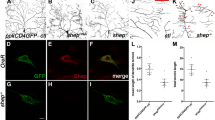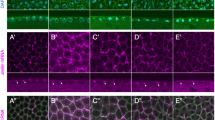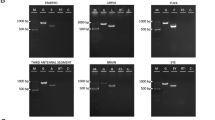Abstract
Midkine (MK) and Pleiotrophin (PTN) are small heparin-binding cytokines with closely related structures. To date, this family of proteins has been implicated in multiple processes, such as growth, survival, and migration of various cells, and has roles in neurogenesis and epithelial–mesenchymal interaction during organogenesis. In this report, we have characterized two members of the MK/PTN family of proteins in Drosophila, named Miple1 and Miple2, from Midkine and Pleiotrophin. Drosophila miple1 and miple2 encode secreted proteins which are expressed in spatially restricted, nonoverlapping patterns during embryogenesis. Expression of miple1 can be found at high levels in the central nervous system, while miple2 is strongly expressed in the developing midgut endoderm. The identification of homologues of the MK/PTN family in this genetically tractable model organism should allow an analysis of their function during complex developmental processes.





Similar content being viewed by others
References
Amet LE, Lauri SE, Hienola A, Croll SD, Lu Y, Levorse JM, Prabhakaran B, Taira T, Rauvala H, Vogt TF (2001) Enhanced hippocampal long-term potentiation in mice lacking heparin-binding growth-associated molecule. Mol Cell Neurosci 17:1014–1024
Asai T, Watanabe K, Ichihara-Tanaka K, Kaneda N, Kojima S, Iguchi A, Inagaki F, Muramatsu T (1997) Identification of heparin-binding sites in midkine and their role in neurite-promotion. Biochem Biophys Res Commun 236:66–70
Bowden ET, Stoica GE, Wellstein A (2002) Anti-apoptotic signaling of pleiotrophin through its receptor, anaplastic lymphoma kinase. J Biol Chem 277:35862–35868
Campos-Ortega JA, Hartenstein V (1997) The embryonic development of Drosophila melanogaster. Springer, Berlin Heidelberg New York
Courty J, Dauchel MC, Caruelle D, Perderiset M, Barritault D (1991) Mitogenic properties of a new endothelial cell growth factor related to pleiotrophin. Biochem Biophys Res Commun 180:145–151
Deuel TF, Zhang N, Yeh HJ, Silos-Santiago I, Wang ZY (2002) Pleiotrophin: a cytokine with diverse functions and a novel signaling pathway. Arch Biochem Biophys 397:162–171
Fabri L, Nice EC, Ward LD, Maruta H, Burgess AW, Simpson RJ (1992) Characterization of bovine heparin-binding neurotrophic factor (HBNF): assignment of disulfide bonds. Biochem Int 28:1–9
Fabri L, Maruta H, Muramatsu H, Muramatsu T, Simpson RJ, Burgess AW, Nice EC (1993) Structural characterisation of native and recombinant forms of the neurotrophic cytokine MK. J Chromatogr 646:213–225
Gryzik T, Muller HA (2004) FGF8-like1 and FGF8-like2 encode putative ligands of the FGF receptor Htl and are required for mesoderm migration in the Drosophila gastrula. Curr Biol 14:659–667
Hayashi K, Kadomatsu K, Muramatsu T (2001) Requirement of chondroitin sulfate/dermatan sulfate recognition in midkine-dependent migration of macrophages. Glycoconj J 18:401–406
Iwasaki W, Nagata K, Hatanaka H, Inui T, Kimura T, Muramatsu T, Yoshida K, Tasumi M, Inagaki F (1997) Solution structure of midkine, a new heparin-binding growth factor. EMBO J 16:6936–6946
Kadomatsu K, Muramatsu T (2004) Midkine and pleiotrophin in neural development and cancer. Cancer Lett 204:127–143
Kadomatsu K, Tomomura M, Muramatsu T (1988) cDNA cloning and sequencing of a new gene intensely expressed in early differentiation stages of embryonal carcinoma cells and in mid-gestation period of mouse embryogenesis. Biochem Biophys Res Commun 151:1312–1318
Kadomatsu K, Huang RP, Suganuma T, Murata F, Muramatsu T (1990) A retinoic acid responsive gene MK found in the teratocarcinoma system is expressed in spatially and temporally controlled manner during mouse embryogenesis. J Cell Biol 110:607–616
Kilpelainen I, Kaksonen M, Avikainen H, Fath M, Linhardt RJ, Raulo E, Rauvala H (2000) Heparin-binding growth-associated molecule contains two heparin-binding beta-sheet domains that are homologous to the thrombospondin type I repeat. J Biol Chem 275:13564–13570
Kojima S, Inui T, Kimura T, Sakakibara S, Muramatsu H, Amanuma H, Maruta H, Muramatsu T (1995) Synthetic peptides derived from midkine enhance plasminogen activator activity in bovine aortic endothelial cells. Biochem Biophys Res Commun 206:468–473
Kojima S, Inui T, Muramatsu H, Suzuki Y, Kadomatsu K, Yoshizawa M, Hirose S, Kimura T, Sakakibara S, Muramatsu T (1997) Dimerization of midkine by tissue transglutaminase and its functional implication. J Biol Chem 272:9410–9416
Kopczynski CC, Davis GW, Goodman CS (1996) A neural tetraspanin, encoded by late bloomer, that facilitates synapse formation. Science 271:1867–1870
Kovesdi I, Fairhurst JL, Kretschmer PJ, Bohlen P (1990) Heparin-binding neurotrophic factor (HBNF) and MK, members of a new family of homologous, developmentally regulated proteins. Biochem Biophys Res Commun 172:850–854
Li YS, Milner PG, Chauhan AK, Watson MA, Hoffman RM, Kodner CM, Milbrandt J, Deuel TF (1990) Cloning and expression of a developmentally regulated protein that induces mitogenic and neurite outgrowth activity. Science 250:1690–1694
Loren CE, Scully A, Grabbe C, Edeen PT, Thomas J, McKeown M, Hunter T, Palmer RH (2001) Identification and characterization of DAlk: a novel Drosophila melanogaster RTK which drives ERK activation in vivo. Genes Cells 6:531–544
Loren CE, Englund C, Grabbe C, Hallberg B, Hunter T, Palmer RH (2003) A crucial role for the anaplastic lymphoma kinase receptor tyrosine kinase in gut development in Drosophila melanogaster. EMBO Rep 4:781–786
Maeda N, Noda M (1998) Involvement of receptor-like protein tyrosine phosphatase zeta/RPTPbeta and its ligand pleiotrophin/heparin-binding growth-associated molecule (HB-GAM) in neuronal migration. J Cell Biol 142:203–216
Maeda N, Nishiwaki T, Shintani T, Hamanaka H, Noda M (1996) 6B4 proteoglycan/phosphacan, an extracellular variant of receptor-like protein-tyrosine phosphatase zeta/RPTPbeta, binds pleiotrophin/heparin-binding growth-associated molecule (HB-GAM). J Biol Chem 271:21446–21452
Maeda N, Ichihara-Tanaka K, Kimura T, Kadomatsu K, Muramatsu T, Noda M (1999) A receptor-like protein-tyrosine phosphatase PTPzeta/RPTPbeta binds a heparin-binding growth factor midkine. Involvement of arginine 78 of midkine in the high affinity binding to PTPzeta. J Biol Chem 274:12474–12479
Merenmies J, Rauvala H (1990) Molecular cloning of the 18-kDa growth-associated protein of developing brain. J Biol Chem 265:16721–16724
Milner PG, Li YS, Hoffman RM, Kodner CM, Siegel NR, Deuel TF (1989) A novel 17 kD heparin-binding growth factor (HBGF-8) in bovine uterus: purification and N-terminal amino acid sequence. Biochem Biophys Res Commun 165:1096–1103
Mitsiadis TA, Salmivirta M, Muramatsu T, Muramatsu H, Rauvala H, Lehtonen E, Jalkanen M, Thesleff I (1995) Expression of the heparin-binding cytokines, midkine (MK) and HB-GAM (pleiotrophin) is associated with epithelial–mesenchymal interactions during fetal development and organogenesis. Development 121:37–51
Muramatsu T (2002) Midkine and pleiotrophin: two related proteins involved in development, survival, inflammation and tumorigenesis. J Biochem (Tokyo) 132:359–371
Muramatsu H, Inui T, Kimura T, Sakakibara S, Song XJ, Maruta H, Muramatsu T (1994) Localization of heparin-binding, neurite outgrowth and antigenic regions in midkine molecule. Biochem Biophys Res Commun 203:1131–1139
Muramatsu H, Zou K, Sakaguchi N, Ikematsu S, Sakuma S, Muramatsu T (2000) LDL receptor-related protein as a component of the midkine receptor. Biochem Biophys Res Commun 270:936–941
Muramatsu H, Zou P, Suzuki H, Oda Y, Chen GY, Sakaguchi N, Sakuma S, Maeda N, Noda M, Takada Y, Muramatsu T (2004) {alpha}4{beta}1- and {alpha}6{beta}1-integrins are functional receptors for midkine, a heparin-binding growth factor. J Cell Sci 117:5405–5415
Nakamura E, Kadomatsu K, Yuasa S, Muramatsu H, Mamiya T, Nabeshima T, Fan QW, Ishiguro K, Igakura T, Matsubara S, Kaname T, Horiba M, Saito H, Muramatsu T (1998) Disruption of the midkine gene (Mdk) resulted in altered expression of a calcium binding protein in the hippocampus of infant mice and their abnormal behaviour. Genes Cells 3:811–822
Nakanishi T, Kadomatsu K, Okamoto T, Ichihara-Tanaka K, Kojima T, Saito H, Tomoda Y, Muramatsu T (1997) Expression of syndecan-1 and -3 during embryogenesis of the central nervous system in relation to binding with midkine. J Biochem (Tokyo) 121:197–205
Owada K, Sanjo N, Kobayashi T, Mizusawa H, Muramatsu H, Muramatsu T, Michikawa M (1999) Midkine inhibits caspase-dependent apoptosis via the activation of mitogen-activated protein kinase and phosphatidylinositol 3-kinase in cultured neurons. J Neurochem 73:2084–2092
Powers C, Aigner A, Stoica GE, McDonnell K, Wellstein A (2002) Pleiotrophin signaling through anaplastic lymphoma kinase is rate-limiting for glioblastoma growth. J Biol Chem 277:14153–14158
Qi M, Ikematsu S, Maeda N, Ichihara-Tanaka K, Sakuma S, Noda M, Muramatsu T, Kadomatsu K (2001) Haptotactic migration induced by midkine. J Biol Chem 276:15868–15875
Raulo E, Chernousov MA, Carey DJ, Nolo R, Rauvala H (1994) Isolation of a neuronal cell surface receptor of heparin binding growth-associated molecule (HB-GAM). Identification as N-syndecan (syndecan-3). J Biol Chem 269:12999–13004
Rauvala H (1989) An 18-kd heparin-binding protein of developing brain that is distinct from fibroblast growth factors. EMBO J 8:2933–2941
Stathopoulos A, Tam B, Ronshaugen M, Frasch M, Levine M (2004) Pyramus and thisbe: FGF genes that pattern the mesoderm of Drosophila embryos. Genes Dev 18:687–699
Stoica GE, Kuo A, Aigner A, Sunitha I, Souttou B, Malerczyk C, Caughey DJ, Wen D, Karavanov A, Riegel AT, Wellstein A (2001) Identification of anaplastic lymphoma kinase as a receptor for the growth factor pleiotrophin. J Biol Chem 276:16772–16779
Stoica GE, Kuo A, Powers C, Bowden ET, Sale EB, Riegel AT, Wellstein A (2002) Midkine binds to anaplastic lymphoma kinase (ALK) and acts as a growth factor for different cell types. J Biol Chem 277:35990–35998
Tezuka K, Takeshita S, Hakeda Y, Kumegawa M, Kikuno R, Hashimoto-Gotoh T (1990) Isolation of mouse and human cDNA clones encoding a protein expressed specifically in osteoblasts and brain tissues. Biochem Biophys Res Commun 173:246–251
Tomomura M, Kadomatsu K, Matsubara S, Muramatsu T (1990) A retinoic acid-responsive gene, MK, found in the teratocarcinoma system. Heterogeneity of the transcript and the nature of the translation product. J Biol Chem 265:10765–10770
Acknowledgements
The authors would like to thank members of the RHP laboratory for fruitful discussions during the course of this work. RHP is a Swedish Cancer Foundation Research Fellow and is supported by the Swedish Research Council (621-2003-3399), the Carl Tryggers Foundation and the Åke Wiberg Foundation.
Author information
Authors and Affiliations
Corresponding author
Additional information
Communicated by P. Simpson
C. Englund, A. Birve, and L. Falileeva contributed equally to this work.
Rights and permissions
About this article
Cite this article
Englund, C., Birve, A., Falileeva, L. et al. Miple1 and miple2 encode a family of MK/PTN homologues in Drosophila melanogaster . Dev Genes Evol 216, 10–18 (2006). https://doi.org/10.1007/s00427-005-0025-8
Received:
Accepted:
Published:
Issue Date:
DOI: https://doi.org/10.1007/s00427-005-0025-8




